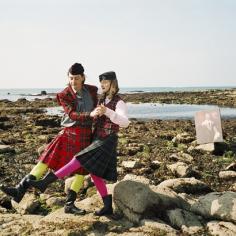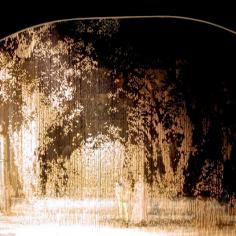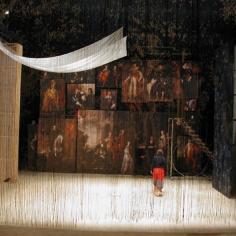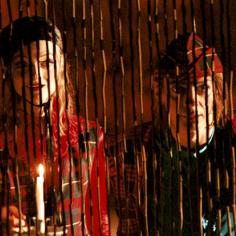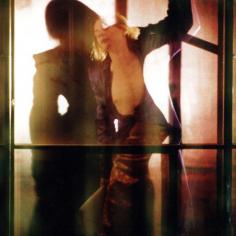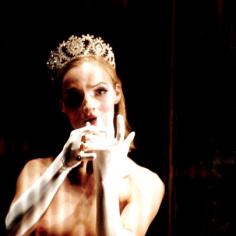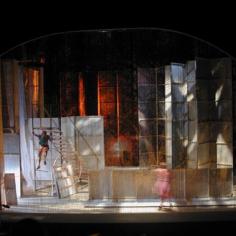2001 · La Bête dans la Jungle · James · Lord · Duras · Vigner (EN)
"Writing isn't telling stories.
It is the contrary of telling stories.
It is everything at the same time.
It is telling a story and the abscence of that story.
It is telling a story which passes through its abscence first."
M.D.
In 2001, Vigner embarks on a diptych on the works of MARGUERITE DURAS.
On 17 October 2001, he directed LA BÊTE DANS LA JUNGLE (THE BEAST IN THE JUNGLE), her adaptation of the play by JAMES LORD based on a novella by HENRY JAMES. For the set design, Vigner is inspired by the three authors: Duras, Lord and James, the two literary forms - a novella and a play - the two languages - English and French - an extraordinary mix to which a number of people contributed, all of whom left strong marks.
JAMES LORD is considered one of the most clear-sighted chroniclers of modern art. He became well known for his monumental biography of ALBERTO GIACOMETTI, followed by biographies of BACON, PICASSO and DORA MAAR... Giacometti painted his portrait. Lord’s BEAST IN THE JUNGLE, his only work for the theatre, has never been published. While respecting the structure of the novella by HENRY JAMES, he introduced in his play a pictorial dimension, the portrait of the Fourth Marquess by VAN DYCK. In the sixties, he collaborates with MARGUERITE DURAS for a french version, which remains unpublished. Only twenty years later, Marguerite Duras finalises the play, turning it into a set of six ‘tableaux’ with a prologue and an epilogue, stressing the notions of time, memory and secrecy. Vigner, for his part, delves into his imaginary museum, which has its roots in the quattrocento - the invention of perspective - and spans the centuries up to modern and contemporary art.
"Not what is represented counts, the subject is painting itself. The subject of theater is the theater itself, its excess, its effects its imaginary."
ÉRIC VIGNER
Throughout the play, the spectator travels through a story, several stories, and also the history of painting. Vigner tries to leave the door open for any interpretation, from reality to illusion, without ever giving an answer. He invites his audience to pass through these images, these spaces, to go beyond them, transgress them, to seek their own way, in order to discover their own history, to find their own intimacy.
Vigner invented a new process for the set that consists of moving images playing with varying focal depths. A FRAGONARD landscape on a bamboo curtain veiled the stage. Space was conjured up by a gallery of VAN DYCK portraits, colours and images which faded and decomposed. The scenography proposes an ocuiar adventure to the audience, a view confronting the uncertainties of an image, the traps of perspective.
For LA BÊTE DANS LA JUNGLE, he chooses two actors who had already embarked on two ventures with him and promised to personify something like a mythical couple of the kind you find in cinema, or a duo in the world of music: JEAN-DAMIEN BARBIN (Rhinocéros) and JUTTA JOHANNA WEISS (Marion de Lorme, Rhinocéros). In this play they become ‘John and Catherine’ like ‘a man and a woman’. They could well be characters out of a 19th-century novel or out of opera, of stories or legends like Alice in Wonderland, characters like old-time music hall stars - or simply a modern couple of our day and age.
"Behind an image there is another one, and as one passes on there’s another and yet another one, until we rid ourselves of the images, until we finally accept merely to be there, in empty space, freed from all appearances."
ÉV
"We are all tears. For we, too, have understood something. ‘What? Hard to say!’ ‘Traces’, ‘little nothings’, ‘fleeting feelings’. The absence of a story, memories of blank space, a tightrope act. Thanks to his two actors and a lyrical scenography - tensioned like the strings of a lyre - Eric Vigner grafts onto it some additional reality. A marvel."
SOPHIE KHAN, Cassandre, mars-avril 2002
"- Some plays leave indelible traces, ineradicable marks, images that surface from time to time, triggered by certain events. This is what remains, the heritage that is never forgotten. - The actors, I think, have interpreted (if not the most beautiful) the strongest, the most necessary play of recent times - independently of the seasons that define history, it ruptures the obbligato rhythm of historicity."
CHRISTOPHE DESHOULIÈRES
LA BÊTE DANS LA JUNGLE ran for a whole month in Lorient. It was notably shown at the Espace Go in Montréal (2002) and the Kennedy Center in Washington (2004).
© Photography : Alain Fonteray
Texts assembled by Jutta Johanna Weiss
Translation from the French by Herbert Kaiser
© CDDB-Théâtre de Lorient
